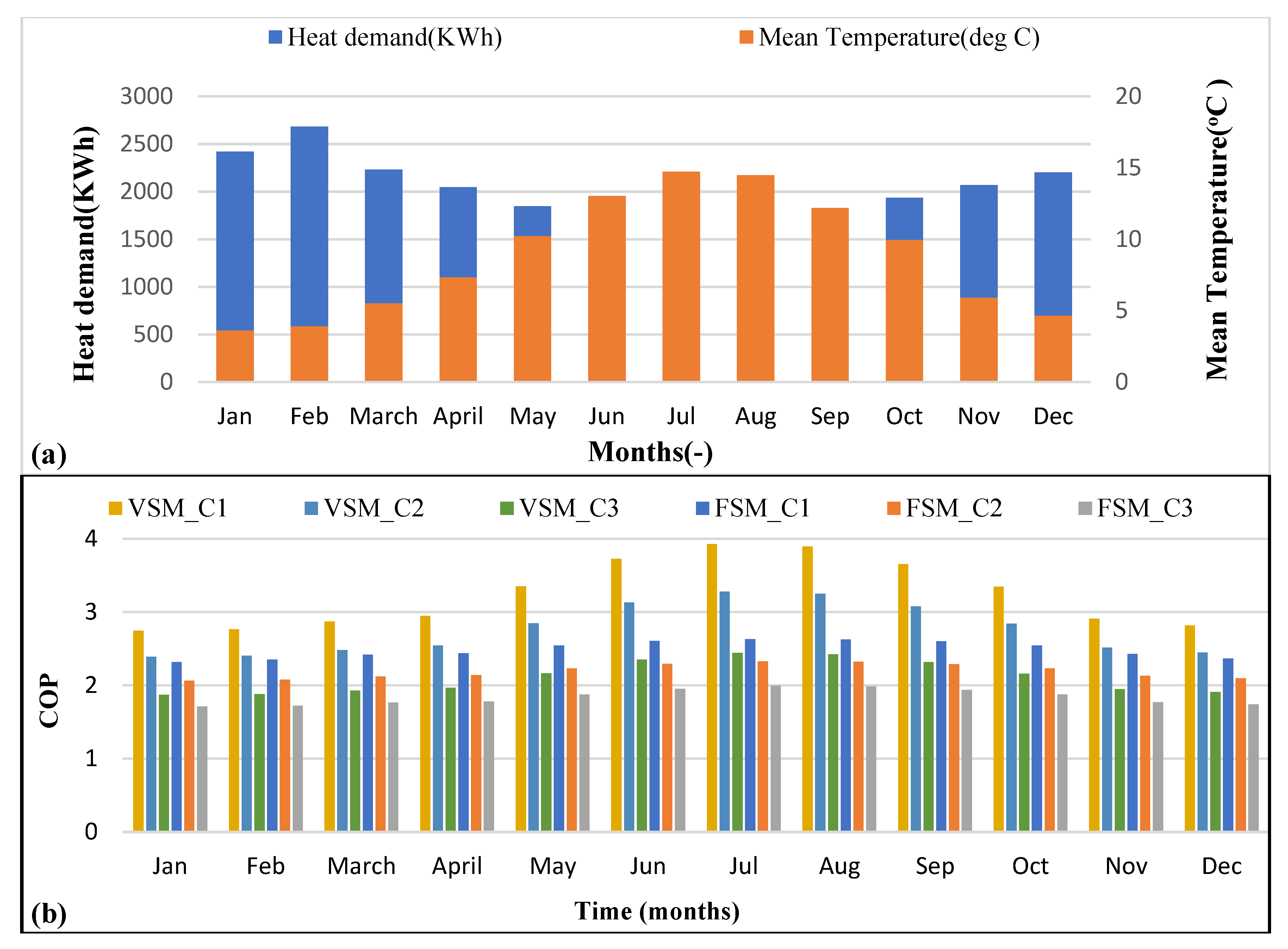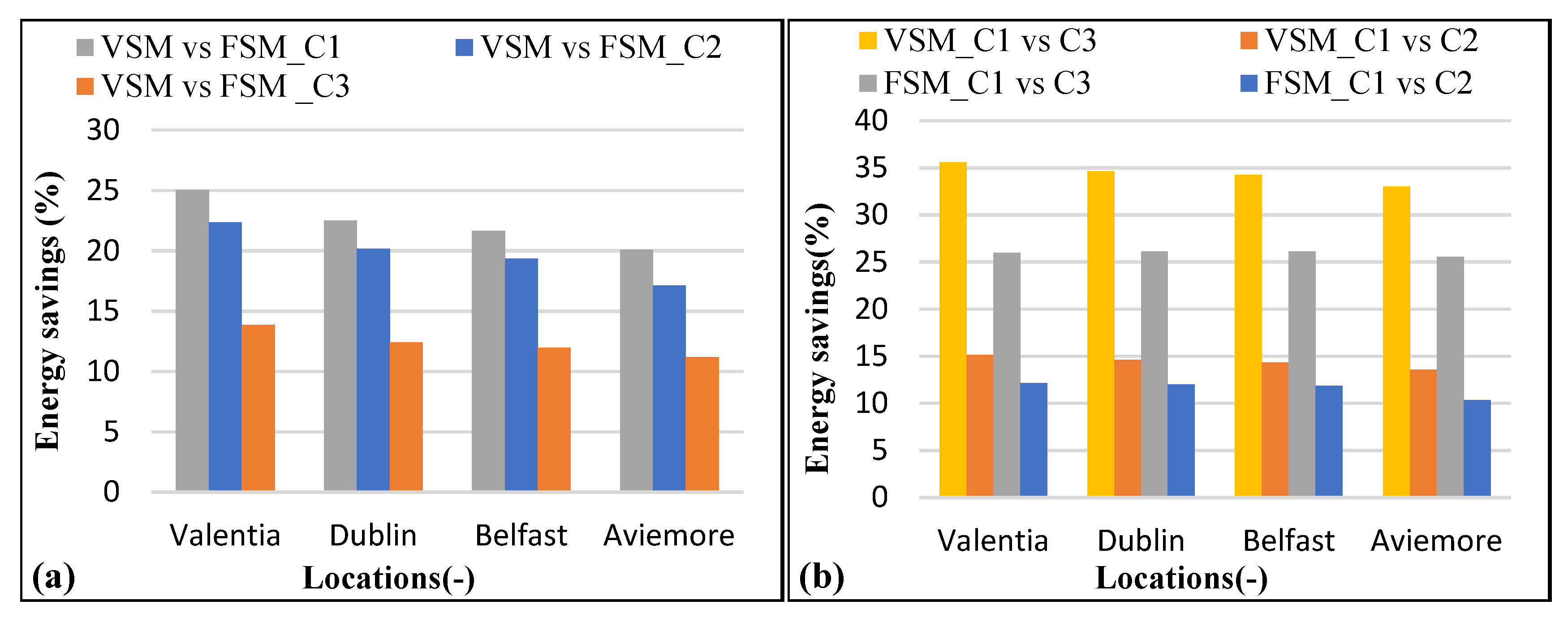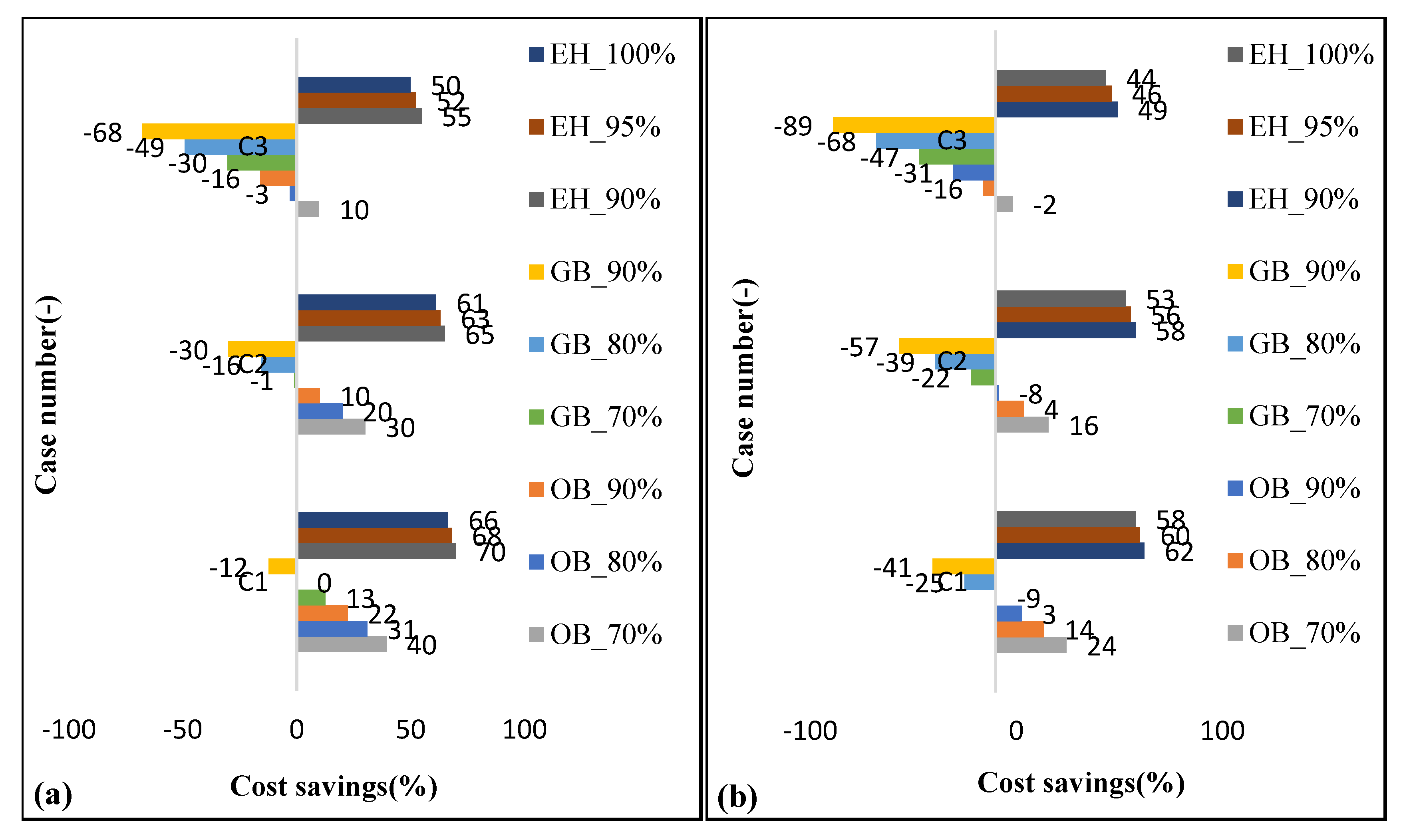Building’s sector is one of the major contributors to the global emissions and was responsible for 38% of greenhouse gas (GHG) emissions in 2019 [
1]. In the UK, the residential sector consumes 29% of the total final energy consumption [
2] and accounted for 17% of the total carbon dioxide emissions [
2]. The recent report by International Energy Agency (IE(A) [
3] says that the sale of new fossil fuel boilers should stop from 2025 to achieve net-zero emissions target by 2050. On the way to net zero emissions, multiple milestones are there and lags in any sector may results in failures to meet the target elsewhere. The energy and climate policy strengthening, and implementation is required by all government to achieve the global pathway to net-zero emissions. The UK as a signatory of this agreement has legislated and set the target of net-zero carbon emission by 2050 [
4,
5], banned sale of fossil fuel-based boilers by 2025 [
6]. The current measures are insufficient towards the committed pathways and hence acceleration in actions is required. In this regard the climate change conference, COP26 [
7] organized in Glasgow, will urge signatory countries to speed up the action required to achieve the goals of Paris climate change agreement. Among the residential sector, space heating (SH) & domestic hot water (DHW) demand consumes 79% while cooking, lighting and other appliances consume the rest [
8]. This encourages the renewable energy-based alternatives including greening gas or heat pump (HP) technology instead of fossil fuel-based heating options to decarbonize the space heat and hot water demand. Domestic heating sector decarbonizations via the greening gas including biomethane or hydrogen appears attractive but seems to be more costly and convincing results is missing in this regard. One of the key milestones settled for the building sector is retrofitting measures and 50% of the heating demands supposed to be met with HP by 2045 [
3]. The electrification of the domestic heating sector via the electric HP become more feasible due to reduction in carbon footprints because of increasing renewable energy integration into the network grids [
9]. The carbon emissions factor reduced by 23% in UK grid electricity during the two years period from 2018–2020 [
10]. The ASHP appears more attractive for retrofit solution compared to the ground source heat pump (GSHP) technology due to the lower initial capital cost, labor work and space required, and less house disruption [
11]. Recently a review study [
12] on ASHP installation in the context of UK found it a promising technology for heating sector decarbonization. The HP as a technology uptake in UK was limited due to issues relating to control, sizing, existing housing stock poor insulation, initial capital cost, and lack of incentives by the government [
13]. The major portion of domestic heating sector representing 62.8% of the total 80,000 dwellings were relying on oil boilers in Northern Ireland (NI) mainly because of off-gas grid areas [
14] and around 85% of the total 27.4 million in England dwellings use gas boilers [
15]. The HP retrofitting inside the very old period housing stock could not be neglected as the number of hard to heat homes in Northern Ireland represent 27.3% [
16], and 43% in England [
17]. The HP replacement instead of gas boilers requires the performance assessment and improvement potential investigation to compete with the falling gas prices in UK. The existing cost analysis allows the HP technology to compete in off-gas grid areas only. The variable speed compressor-based system could produce range of heating capacity [
18] at low to high heat supply temperature could result in performance improvement and reduce carbon emissions and cost. The HP investigation as a domestic retrofit technology is presented in this study considering the control, heat supply temperature impact and climatic conditions impact on system performance.
1.1. Literature Review
The HP system classified depending on the heat supply temperature, as low temperature (35 °C), medium temperature (45 °C), high temperature (55 °C), and very high temperature (above 65 °C) (BS EN14511, 2004) [
19]. The role of HP as a low carbon retrofit technology will surely increase among the UK domestic sector but certain factors influencing the installations inside the existing buildings including the high temperature distribution system must be carefully assessed [
13]. Around 27.5 million England residential buildings [
20] are old aged, installed with wet radiators as a heating distribution system. The wet radiators are installed to work with gas/oil boiler [
21] efficiently at very high heat supply temperature of 75 °C, as per BS-EN 442-2:201 standard 4 recommendations [
22]. In contrast the HP system works efficiently at lower heat supply temperature. The replacement of heating distribution system inside the existing house will be a major disruption. However, the pros and cons including the efficiency improvement and carbon emissions savings comparison is important to provide solid information to the policy makers and homeowners. The HP studies as a domestic retrofit technology could mainly be divided into two categories based on the supply temperature, i.e., (a) low to medium (35–45 °C) and high supply temperature (55 °C), and (b) very high supply temperature (60 °C and above). The literature on the domestic retrofit applications were mainly based on the predictions/and field trials of the commercially available units, manufacturer data information with no control over supply temperature, assuming nominal value for heat supply temperature [
23,
24], and without considering the heat supply temperature, control mode, building insulations, climatic conditions simultaneous impact. HP retrofit studies for different HP types have been conducted without proper design considerations and experimental development, neglecting the impact on compressor life. Lab tests at individual heating capacity and test conditions were conducted with variable speed compressor-based system and were recommended for further studies for domestic retrofit [
25]. The effect of climatic conditions considerations along with building insulation level as a retrofit technology was assessed with other type of heat pumps [
26]. The ASHP type needs special attention due to inverse relationship of building heat demand and heat production in winter [
27]. The variable speed compressor-based system could produce a range of heating capacities could avoid the oversizing. Therefore, the proper sizing and experimental results become more critical and assessment studies are required prior to installation of such system in a specific building type, and country location. Earlier studies for different nationalities were available in literature with a focus on different aspects. In this regard, the study of Madonna and Bazzocchi [
23] evaluated the seasonal performance factor (SPF) in retrofit applications for different building types, in Italy climatic conditions at 45 °C supply temperature nominal value assumptions, reporting the potential improvement of 19% via weather compensation strategy. The study assumed radiators oversizing without looking into heating distribution system installations/upgradations requirements, heat supply temperature impact on the carbon emissions, cost, and operating mode of control. Asaee et al. [
28] evaluated the feasibility of ASHP retrofit installation for the eligible Canadian housing stock for the combined SH and DHW demand. The final heat supply temperature of 55 °C were obtained in the second stage via auxiliary boilers and 50 °C was achieved by the HP in first stage. The HP retrofitting could save energy of 36%, with up to 23% reduction in greenhouse gas emissions in comparison to fossil fuel-based heating technologies. However, the study reported mainly the high-level impact on the carbon emission without looking into the technological depth and improvement. In Germany, the experimental data from the field trials results of 21 ASHP system and 22 GSHP was assessed for retrofit applications by Huchtemann [
29]. The heat supplying temperature was 40 °C for underfloor heating options and 55 °C when radiators were used with ON/OFF controlled mode only. The study investigating ASHP replacement instead of gas boiler in UK assessing the carbon-savings, annual running cost in the existing office considering the insulation improvement characteristics by 2030 scenario [
30]. The ASHP was found potential decarbonization technology and the amount of carbon emission reduction was based on the future DHW supply and the grid carbon intensity. The ASHP retrofit study for residential buildings in Scotland [
9], was conducted by Kelly and Cockroft for the evaluation of annual running cost and carbon emission at supply temperature of 55 °C. The HP retrofitting instead of gas boilers reduces 12% carbon emissions, but with increase of 10% annual running cost. Cabrol and Rowley [
31] compared the simulation results in domestic buildings at single heat supply temperature of 35 °C with no comparative results for other supply temperature in UK climatic conditions. The ASHP was found effective both in terms of carbon emission and cost due to low supply temperature in contrast to the gas boilers. Department of Energy and Climate Change (DECC) in combination with the Energy Saving Trust (EST) [
32] investigating the field trials results in UK for AWHPs and GSHPs, ranging from 30 °C to 55 °C heat supply temperature. The study concluded that the lower HP performance in UK compared to other European countries were due to lack of match between capacity and demand, large floor area, sizing issue, lack of proper control, and ignoring the house insulation characteristics due to different age period. The conclusions drawn were similar to those by the authors of [
33]. Hybrid heat pump-gas boiler system combination was investigated by Bagarella [
34] with the aim of reduction the unfavorable behavior of the ASHP during the coldest period of the year to investigate the impact on annual energy saving. Two climatic conditions with several simulations were considered using developed dynamic model. The importance of proper sizing of the HP was highlighted, with the hybrid system more economical in comparison to monovalent HP. The only study [
35] investigated ASHP as a domestic retrofit technology instead of gas boiler in south of Italy for cost and energy consumption while considering the heating system installations cost in combination with electricity and/or gas bills. However, the focus was the building insulations. The importance of building heat demand factor for cost savings with the HP was highlighted.
In the context of UK, variable speed compressor HP system retrofit for old age house was identified as one of the optimal possible heating technologies at low to medium and high supply temperature [
36]. However, the seasonal performance was not assessed and were recommended for further investigations. The issue with the HP retrofit in the existing housing stock is the poor performance of the at higher supply temperature and needs the replacement of the existing wet radiators either with modern radiators or underfloor heating system. This adds extra cost to the higher initial capital cost of the HP. None of the above studies considered the additional installations cost and comparing the benefits of lower heating supply with high heat supply temperature. The additional heating distribution allows the HP to work efficiently at low to medium and high heat supply temperature retrofit, but with extra cost.
The heating distribution system installations could be avoided in case of second category of very high heat supply temperature of 60 °C and above. The earlier studies with very high heat supply temperature, including economized vapor injection (EVI), cascaded unit were developed and assessed for the 1900s Mid terraced test house considered in our analysis for Belfast climatic conditions, were found expensive in terms of annual running cost [
24,
25,
37,
38], with some savings of carbon emissions. The technoeconomic study [
24] for the ASHP retrofit inside the test house was conducted at supply temperature of 75 °C to compare the HP annual running costs to that of gas boiler. The annual running cost for the HP was found higher than the gas boiler with a cut on carbon emissions in the range of 14% to 57% depending on the boiler’s efficiency. A comparative result with the very high temperature retrofitted HP is required to compare the carbon emissions savings and move towards net zero carbon targets. The domestic retrofit study with low to medium, high, and very high supply temperature with variable speed diesel engine heat pump system development, illustrating the advantages of high temperature engine driven HP in remote areas (off gas/ electricity networks), while meeting the reference test house heat demand have been reported in [
39,
40]. The engine was operated at various speed, with low to high supply temperature for possible potential benefits with variable speed mode of control for energy savings and system operations optimization.
The seasonal co-efficient of performance (COP), defined as the ratio between the useful energy heat output to the electrical energy consumed during a specific time, have been calculated using different approaches in the literature. The model validation through experimental results is important for the system performance predictions. In this regard, Kinab et al. [
41] formulated a detailed model for variable speed ASHP seasonal performance optimization. The seasonal performance for Nice, Nancy, Macon and Trappers were of the order of 3.27, 2.76, 2.93, and 2.93, respectively, at single heat supply temperature of 45 °C. A simple but novel numerical model for the seasonal performance for Bologna city of Italy for three different kinds ASHP system (i.e., mono/multi, and variable speed compressor) was developed by Dongellini et al. [
42]. The seasonal performance value of 3.8 was achieved at heat supply temperature of 35 °C in VSM. The HP used for comparative evaluation were different which sometime could lead to misleading information, and the results were based on the manufacturer data. The issue of frosting with ASHP system was studied [
43] and its impact on the seasonal performance evaluations, using the developed model [
42]. Other seasonal performance evaluation approaches including parametric model was developed by Underwood et al. [
44] with the possibility of validation with lab scale/field trials, and manufacture results for the seasonal performance evaluation. The part load operation considering the HP part load factor was not modelled and were recommended for further investigations. An empirical model was developed for DHW production to find the performance of HP and maximize benefit for the substitution with gas boilers in [
45]. The approach developed in [
42] were adapted for the seasonal performance evaluation.
Although the main objective of this study was not the investigation of the comparative performance results with the VSM and FSM, the discussion become important for the benefits associated with the retrofit. The literature on the topic of variable speed control was limited to the specific technical and/or economic benefits of variable speed control technology, and energy saving potentials. The high starting current associated with ON/OFF control resulting in extra pressure on the network was found one of the barriers for HP technology uptake inside UK, compared to other European countries [
46]. The restart of the unit during ON/OFF control results in high current consumption and lower efficiency because of compressor pressures re-establishment requirements. The risk of network instability due to current load further increases with the requirements of back-up electric heater requirements when the ASHP is unable to meet the required load at very low ambient temperature. The variable speed compressor of the HP for the capacity control have proved more efficient in this context [
47,
48,
49]. Conventional way of controlling the heating capacity is the intermittent operation of compressor and comparative study between the variable speed and on/off control have been conducted by [
50,
51,
52,
53,
54,
55,
56] reporting an efficiency improvement in the range of 10–25% [
57]. The reason for performance improvement was better part load efficiency, match between the supply and demand, a smaller number of on/off cycles, unloading of heat exchangers, less requirements for back up electric heater, and smaller frosting losses [
58]. Experimental and theoretical analysis were proposed by Zhao el al. [
59] including the on/off control. The study concluded variable speed operation as more suitable approach for COP improvement. Munari et al. [
60] performed comparative study of the two modes of control for the energy performance in terms of heat supply temperature requirements, with the additional consideration of compressor efficiency, and climatic conditions impact studied by Adhikari et al., 2012 [
61]. The backup electric heating requirements was studied by Karlsson and Fahlen [
62]. The three climatic conditions of Italy (Milan, Rome, Palermo, and significant energy savings with variable speed control specifically at Palermo and Rome during the heating seasons because of part load operation of the system for most of the time were investigated in [
61]. The heat supply temperature in the ON/OFF control mode during the on-cycle needs to be higher compared to the continuous system operation which leads to lower performance and higher energy consumptions [
63]. The studies found in the literature combining the comparative study of heat supply temperature (low to medium), and control mode (ON/OFF vs. VSM) with ground source heat pump (GSHP) aiming at the system efficiency improvement was found in [
64,
65]. The impact of hydronic heating distribution system on the HP performance with different supply/return temperature without considering the economic, insulation, property type, and climatic conditions impact [
64,
65]. The reduction in water supply/return temperature values from 55/45 °C to 35/28 °C results in increasing seasonal performance in the range of 30–35%. A couple of experimental studies comparing the two control modes aiming at industrial applications was conducted by [
66,
67] aiming at the performance improvement potential and energy saving potential. The previous studies on the developed HP as a retrofit technology highlights the cost as the major barrier for the HP system installation in the UK [
36,
37].


















